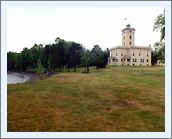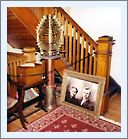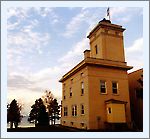|
Historical
Information

With the 1845 bonanza copper strike at the nearby Cliff Mine, the
natural harbor at Eagle River quickly boomed as the shipping point for
the mine's bounty. With a seemingly endless parade of vessels delivering
immigrant miners and supplies and shipping copper though the Sault locks
to the company's smelters in Pittsburgh, it was clear that an aid to
navigation was necessary to guide the growing vessel traffic safely into
the bustling harbor.
At the Fifth Auditor's recommendation, Congress appropriated the sum of
$4,000 for the construction of the Eagle
River Light Station in 1850, with the station illuminated four
years later.
Together, the Cliff Mine and Eagle River continued to flourish, with the
construction of huge stamping mills, warehouses, and streets lined
solidly with boarding houses, saloons and miner's homes to serve the
burgeoning population.
With every boom, there is an inevitable bust. Declining copper prices
slowed the Cliff Mine's output, and by the late 1860's Eagle River had
become a virtual ghost town. With the mine's closure in 1873, Eagle
River's once busy docks sat rotting, and without maritime traffic, the
river mouth became silted to a point that the harbor became inaccessible
to all but the shallowest draft vessels.
By 1890, virtually the only vessel making its way into the harbor was
the lighthouse tender on its annual supply trips, and the Lighthouse
Board was well aware of the futility of continuing to maintain a light
to protect a non-existent harbor.
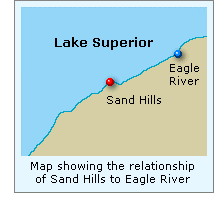 In its 1892 annual report, the Lighthouse Board noted that traffic
patterns on the lake had changed, and that eastbound vessels were making
a turn off Sand Hills, some twelve miles to the west of Eagle River, and
approximately midway between the coast lights of Ontonagon and Eagle Harbor. With the treacherous Sawtooth Reef located just offshore at this
point, the Board recommended to Congress that $20,000 be appropriated to
decommission the light at Eagle River, and construct a new coast light
at Sand Hills.
In its 1892 annual report, the Lighthouse Board noted that traffic
patterns on the lake had changed, and that eastbound vessels were making
a turn off Sand Hills, some twelve miles to the west of Eagle River, and
approximately midway between the coast lights of Ontonagon and Eagle Harbor. With the treacherous Sawtooth Reef located just offshore at this
point, the Board recommended to Congress that $20,000 be appropriated to
decommission the light at Eagle River, and construct a new coast light
at Sand Hills.
Congress responded with an act authorizing the construction of the new
station on February 15, 1893, but failed to make an appropriation for
the necessary funds. While the Board reiterated the need for the
appropriation in each of its' annual reports for the following seven
years, no moneys were forthcoming. Citing rising costs, in its 1899
annual report, the Board increased its estimate of the necessary funds
to $25,000, an amount which subsequently grew to $38,000 in its 1902
report, and yet Congress still failed to authorize the necessary funds.
The Board continued to request the $38,000 in every subsequent annual
report through 1907, when it finally abandoned the project, and ceased
to mention the planned station. The Eagle River Light Station was
decommissioned in 1908, and with no light between Ontonagon to Eagle
Harbor, mariners making their way along the coast were forced to run
blind at night.
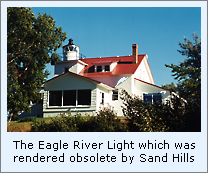 With the elimination of the Lighthouse Board in 1910, responsibility for
the nation's lighthouses was transferred to George R. Putnam who was
appointed to the newly formed position of "Commissioner of
Lighthouses" under the Treasury Department. In his 1911 annual
report to Congress, Putnam again picked up the call for the elimination
of the Eagle River light, and the erection of a new light station at
Sand Hills. Reporting that ten vessels had stranded on Sawtooth Reef
over the past decade with resulting losses in excess of a million
dollars, Putnam's revised proposal for the Sand Hills light station
called for an appropriation of $75,000 for the construction of both a
coast light and fog signal station.
With the elimination of the Lighthouse Board in 1910, responsibility for
the nation's lighthouses was transferred to George R. Putnam who was
appointed to the newly formed position of "Commissioner of
Lighthouses" under the Treasury Department. In his 1911 annual
report to Congress, Putnam again picked up the call for the elimination
of the Eagle River light, and the erection of a new light station at
Sand Hills. Reporting that ten vessels had stranded on Sawtooth Reef
over the past decade with resulting losses in excess of a million
dollars, Putnam's revised proposal for the Sand Hills light station
called for an appropriation of $75,000 for the construction of both a
coast light and fog signal station.
Once again, the pleas for this station echoed unheeded through the halls
of Congress, and Putnam repeated his request in each of his subsequent
annual reports until Congress finally responded favorably with an
appropriation of $70,000 for the project on June 12, 1917.
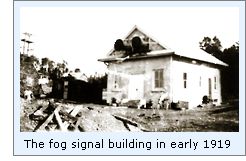 Putnam acted quickly, with a forty-seven acre site selected, surveyed,
and purchased that summer. By the close of navigation for 1917,
contracts had been issued for virtually all of the materials required
for construction, the site had been cleared, and the concrete foundation
for the structure was poured. Putnam acted quickly, with a forty-seven acre site selected, surveyed,
and purchased that summer. By the close of navigation for 1917,
contracts had been issued for virtually all of the materials required
for construction, the site had been cleared, and the concrete foundation
for the structure was poured.
Work resumed the following spring, with the establishment of a temporary
lens-lantern light and electrically-operated fog signal. The work crew
then turned its attention to the simultaneous construction of both the
fog signal building and the lighthouse proper, which lasted through the
end of that year and into 1919.
The fog-signal building was erected on a solid concrete slab, with its
walls constructed of hollow tile with an exterior stucco coating. In
order to ensure that the fog signal would always be operational, a
redundant system of dual type
"F" diaphone fog signals with duplicate compressors
and oil engines was installed. Such a dual installation ensured that one
unit was always operational when maintenance was being performed on the
other. Each diaphone fed its signal through a cast iron
"trumpet" resonator protruding through the wall of the
building, which concentrated the sound and projected it seven miles
across the lake. Work on the fog-signal was completed in May 1919, and
was officially put into service on May 15.
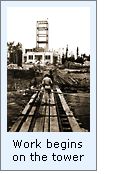 The plans for the Sand Hills lighthouse were some of the most ambitious
ever proposed for a light station, and called for a combined yellow
brick light tower and triple dwelling, with the 70-foot tall tower
centered in the building. The tower itself was built around a steel
girder support system with concrete floors and a cast iron stairway, and
was designed as a self-contained fireproof central core to reduce the
chance of a fire in the tower spreading into the dwellings. The second
floor of the tower served as a central office, and each of the three
adjoining apartments had its own entrance into the tower. The plans for the Sand Hills lighthouse were some of the most ambitious
ever proposed for a light station, and called for a combined yellow
brick light tower and triple dwelling, with the 70-foot tall tower
centered in the building. The tower itself was built around a steel
girder support system with concrete floors and a cast iron stairway, and
was designed as a self-contained fireproof central core to reduce the
chance of a fire in the tower spreading into the dwellings. The second
floor of the tower served as a central office, and each of the three
adjoining apartments had its own entrance into the tower.
While directly connected to the tower, each apartment was constructed as
a separate entity, with all connecting walls being built of brick, once
again designed to stop the spread of a possible fire from one apartment
into an adjacent unit or into the tower.
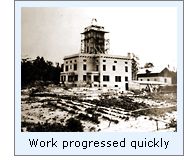 Each apartment was outfitted with hardwood floors, with all interior
walls built of stud construction, and finished-out with hardwood trim
and doors. Each apartment sat on its own cellar, and surrounding central
basement which housed the equipment for the station's hot water central
heating and pneumatic water supply systems. The brick exterior of the
building was finished with cut stone balustrades and cornices, and the
roofs of each of the dwellings was sheathed with durable copper
sheeting. Each apartment was outfitted with hardwood floors, with all interior
walls built of stud construction, and finished-out with hardwood trim
and doors. Each apartment sat on its own cellar, and surrounding central
basement which housed the equipment for the station's hot water central
heating and pneumatic water supply systems. The brick exterior of the
building was finished with cut stone balustrades and cornices, and the
roofs of each of the dwellings was sheathed with durable copper
sheeting.
The tower was crowned with a cast iron deck and a prefabricated circular
cast-iron lantern of 7' 1" inside diameter furnished with curved
glass and diagonal astragals. The Fourth
Order Fresnel lens, manufactured by Henry-Lepaute of Paris was
mounted on a ball-bearing race and rotated by a standard clockwork
mechanism. Equipped with a 35 millimeter incandescent oil vapor lamp,
the lens was designed to rotate at a rate which would show a fixed light
with a characteristic flash every ten seconds, and by virtue of its 91
foot focal plane, was designed to be visible for a distance of 18 miles
in clear weather.
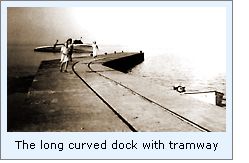 A concrete dock was constructed at the waters edge for the unloading of
supplies, and a tramway constructed from the dock to the station
buildings to facilitate the movement of supplies. A concrete dock was constructed at the waters edge for the unloading of
supplies, and a tramway constructed from the dock to the station
buildings to facilitate the movement of supplies.
Work on the lighthouse was completed in June of 1919, and Head Keeper
William Richard Bennetts exhibited the light for the first time on June
18 of that same year.
Sand Hills remained manned for only twenty years. In 1939, the Coast
Guard assumed responsibility for the nation's aids to navigation, and
automated the light with the installation of an acetylene lamp with
automatic sun valve, thus eliminating the costs associated with the
station's three keepers. With the closure of the station William
Bennetts retired from service, after having served as the station's sole
head keeper throughout all of its manned operation.
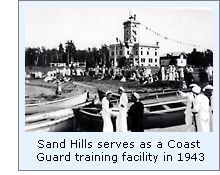 The station stood empty until 1942 when it was temporarily reopened as a
wartime Coast Guard training facility, in which guise it served as home
and school to over 200 trainees at a time. The buildings were closed and
locked the following year, and the station was once again went empty. The station stood empty until 1942 when it was temporarily reopened as a
wartime Coast Guard training facility, in which guise it served as home
and school to over 200 trainees at a time. The buildings were closed and
locked the following year, and the station was once again went empty.
In 1954, with improvements in weather forecasting and the adoption of
radar, it was determined that the light was no longer necessary. The
stationed was decommissioned and the Sand Hills name was forever removed
from the official listings of aids to navigation.
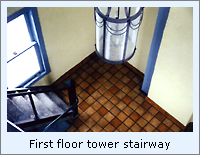 The lighthouse was turned over to the General Services Administration
for liquidation. Offered at public auction in 1958, the entire station
property was purchased for the princely sum of $26,00 by H. Donald
Bliss, and insurance agent from the Detroit area. Bliss and his family
used the structure as their private summer cottage for the next few
years. While it was reported that Bliss had plans to restore the
structure, they never came to fruition as the property was once again
offered for sale in 1961. The lighthouse was turned over to the General Services Administration
for liquidation. Offered at public auction in 1958, the entire station
property was purchased for the princely sum of $26,00 by H. Donald
Bliss, and insurance agent from the Detroit area. Bliss and his family
used the structure as their private summer cottage for the next few
years. While it was reported that Bliss had plans to restore the
structure, they never came to fruition as the property was once again
offered for sale in 1961.
Detroit photographer and artist Bill Frabotta purchased the station,
converting the fog signal building into a summer cottage where he and
his wife Eva spent the following 30 years walking the halls of the
station building planning their upcoming restoration. After a
comprehensive three year renovation undertaken between 1992 and 1995,
the building was reopened as one of the nation's premier bed and
breakfast inns.

Keepers of
this Light

Click here
to see a complete listing of all Sand Hills Light keepers compiled by
Phyllis L. Tag of Great Lakes Lighthouse Research.

Seeing this Light

We have yet
to visit this light. However Larry Diegel, who is working with Bill
Frabotta in the restoration project, has been kind enough to photograph
the station and some of the historical photographs in Bill's station
archives for inclusion on our website. A big thanks to Larry and Bill
for sharing these images.

Finding this
Light
Follow Hwy. 41 North into the village of Ahmeek, and turn left at the
first street. Follow the signs directing you to Five Mile Point Road,
where you will then continue the eight miles to the lighthouse. There
are signs for the lighthouse along the road.

Contact
information

Sand Hills Lighthouse Inn
Five Mile Point Road P.O. Box 414
Ahmeek, MI 49901
(906) 337-1744
Click
here to visit
Bill Frabotta's Sand Hills Bed & Breakfast Inn web
site.

Reference
Sources

 Annual reports of the Lighthouse Board, 1890 through 1910.
Annual reports of the Lighthouse Board, 1890 through 1910.
Annual reports of the Commissioner of Lighthouses, 1911 through 1929.
Annual reports of the Lake Carriers Association, 1909 through 1919.
Lake Superior, Grace Lee Nute, 1944, 1972
Contemporary Photographs courtesy of Larry Diegel.
Historic photographs courtesy Bill Frabotta's Sand Hills Lighthouse
Archives.
Ready for Lighthouse Keeping, Detroit News, 11/16/1958.
The Story of Sand Hills Light, H. Donald Bliss, 1960.
Keeper listings for this light appear
courtesy of Great
Lakes Lighthouse Research
|
